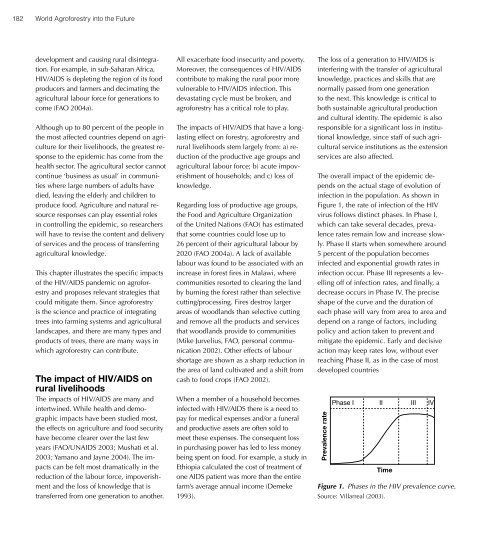The challenge of HIV/AIDS: Where does agroforestry fit in? - World ...
The challenge of HIV/AIDS: Where does agroforestry fit in? - World ...
The challenge of HIV/AIDS: Where does agroforestry fit in? - World ...
You also want an ePaper? Increase the reach of your titles
YUMPU automatically turns print PDFs into web optimized ePapers that Google loves.
182<strong>World</strong> Agr<strong>of</strong>orestry <strong>in</strong>to the Futuredevelopment and caus<strong>in</strong>g rural dis<strong>in</strong>tegration.For example, <strong>in</strong> sub-Saharan Africa,<strong>HIV</strong>/<strong>AIDS</strong> is deplet<strong>in</strong>g the region <strong>of</strong> its foodproducers and farmers and decimat<strong>in</strong>g theagricultural labour force for generations tocome (FAO 2004a).Although up to 80 percent <strong>of</strong> the people <strong>in</strong>the most affected countries depend on agriculturefor their livelihoods, the greatest responseto the epidemic has come from thehealth sector. <strong>The</strong> agricultural sector cannotcont<strong>in</strong>ue ‘bus<strong>in</strong>ess as usual’ <strong>in</strong> communitieswhere large numbers <strong>of</strong> adults havedied, leav<strong>in</strong>g the elderly and children toproduce food. Agriculture and natural resourceresponses can play essential roles<strong>in</strong> controll<strong>in</strong>g the epidemic, so researcherswill have to revise the content and delivery<strong>of</strong> services and the process <strong>of</strong> transferr<strong>in</strong>gagricultural knowledge.This chapter illustrates the specific impacts<strong>of</strong> the <strong>HIV</strong>/<strong>AIDS</strong> pandemic on agr<strong>of</strong>orestryand proposes relevant strategies thatcould mitigate them. S<strong>in</strong>ce agr<strong>of</strong>orestryis the science and practice <strong>of</strong> <strong>in</strong>tegrat<strong>in</strong>gtrees <strong>in</strong>to farm<strong>in</strong>g systems and agriculturallandscapes, and there are many types andproducts <strong>of</strong> trees, there are many ways <strong>in</strong>which agr<strong>of</strong>orestry can contribute.<strong>The</strong> impact <strong>of</strong> <strong>HIV</strong>/<strong>AIDS</strong> onrural livelihoods<strong>The</strong> impacts <strong>of</strong> <strong>HIV</strong>/<strong>AIDS</strong> are many and<strong>in</strong>tertw<strong>in</strong>ed. While health and demographicimpacts have been studied most,the effects on agriculture and food securityhave become clearer over the last fewyears (FAO/UN<strong>AIDS</strong> 2003; Mushati et al.2003; Yamano and Jayne 2004). <strong>The</strong> impactscan be felt most dramatically <strong>in</strong> thereduction <strong>of</strong> the labour force, impoverishmentand the loss <strong>of</strong> knowledge that istransferred from one generation to another.All exacerbate food <strong>in</strong>security and poverty.Moreover, the consequences <strong>of</strong> <strong>HIV</strong>/<strong>AIDS</strong>contribute to mak<strong>in</strong>g the rural poor morevulnerable to <strong>HIV</strong>/<strong>AIDS</strong> <strong>in</strong>fection. Thisdevastat<strong>in</strong>g cycle must be broken, andagr<strong>of</strong>orestry has a critical role to play.<strong>The</strong> impacts <strong>of</strong> <strong>HIV</strong>/<strong>AIDS</strong> that have a longlast<strong>in</strong>geffect on forestry, agr<strong>of</strong>orestry andrural livelihoods stem largely from: a) reduction<strong>of</strong> the productive age groups andagricultural labour force; b) acute impoverishment<strong>of</strong> households; and c) loss <strong>of</strong>knowledge.Regard<strong>in</strong>g loss <strong>of</strong> productive age groups,the Food and Agriculture Organization<strong>of</strong> the United Nations (FAO) has estimatedthat some countries could lose up to26 percent <strong>of</strong> their agricultural labour by2020 (FAO 2004a). A lack <strong>of</strong> availablelabour was found to be associated with an<strong>in</strong>crease <strong>in</strong> forest fires <strong>in</strong> Malawi, wherecommunities resorted to clear<strong>in</strong>g the landby burn<strong>in</strong>g the forest rather than selectivecutt<strong>in</strong>g/process<strong>in</strong>g. Fires destroy largerareas <strong>of</strong> woodlands than selective cutt<strong>in</strong>gand remove all the products and servicesthat woodlands provide to communities(Mike Jurvelius, FAO, personal communication2002). Other effects <strong>of</strong> labourshortage are shown as a sharp reduction <strong>in</strong>the area <strong>of</strong> land cultivated and a shift fromcash to food crops (FAO 2002).When a member <strong>of</strong> a household becomes<strong>in</strong>fected with <strong>HIV</strong>/<strong>AIDS</strong> there is a need topay for medical expenses and/or a funeraland productive assets are <strong>of</strong>ten sold tomeet these expenses. <strong>The</strong> consequent loss<strong>in</strong> purchas<strong>in</strong>g power has led to less moneybe<strong>in</strong>g spent on food. For example, a study <strong>in</strong>Ethiopia calculated the cost <strong>of</strong> treatment <strong>of</strong>one <strong>AIDS</strong> patient was more than the entirefarm’s average annual <strong>in</strong>come (Demeke1993).<strong>The</strong> loss <strong>of</strong> a generation to <strong>HIV</strong>/<strong>AIDS</strong> is<strong>in</strong>terfer<strong>in</strong>g with the transfer <strong>of</strong> agriculturalknowledge, practices and skills that arenormally passed from one generationto the next. This knowledge is critical toboth susta<strong>in</strong>able agricultural productionand cultural identity. <strong>The</strong> epidemic is alsoresponsible for a significant loss <strong>in</strong> <strong>in</strong>stitutionalknowledge, s<strong>in</strong>ce staff <strong>of</strong> such agriculturalservice <strong>in</strong>stitutions as the extensionservices are also affected.<strong>The</strong> overall impact <strong>of</strong> the epidemic dependson the actual stage <strong>of</strong> evolution <strong>of</strong><strong>in</strong>fection <strong>in</strong> the population. As shown <strong>in</strong>Figure 1, the rate <strong>of</strong> <strong>in</strong>fection <strong>of</strong> the <strong>HIV</strong>virus follows dist<strong>in</strong>ct phases. In Phase I,which can take several decades, prevalencerates rema<strong>in</strong> low and <strong>in</strong>crease slowly.Phase II starts when somewhere around5 percent <strong>of</strong> the population becomes<strong>in</strong>fected and exponential growth rates <strong>in</strong><strong>in</strong>fection occur. Phase III represents a levell<strong>in</strong>g<strong>of</strong>f <strong>of</strong> <strong>in</strong>fection rates, and f<strong>in</strong>ally, adecrease occurs <strong>in</strong> Phase IV. <strong>The</strong> preciseshape <strong>of</strong> the curve and the duration <strong>of</strong>each phase will vary from area to area anddepend on a range <strong>of</strong> factors, <strong>in</strong>clud<strong>in</strong>gpolicy and action taken to prevent andmitigate the epidemic. Early and decisiveaction may keep rates low, without everreach<strong>in</strong>g Phase II, as <strong>in</strong> the case <strong>of</strong> mostdeveloped countriesPrevalence ratePhase I II III IVTimeFigure 1. Phases <strong>in</strong> the <strong>HIV</strong> prevalence curve.Source: Villarreal (2003).




![MNC_00_Modau [Compatibility Mode].pdf](https://img.yumpu.com/51432208/1/190x146/mnc-00-modau-compatibility-modepdf.jpg?quality=85)











